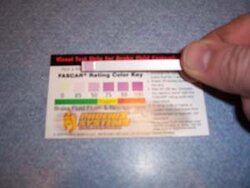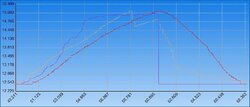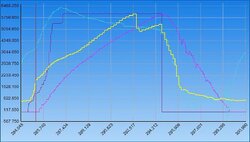Hopefully this doesn't turn in to a "Jakee" thread  , but we'll see....
, but we'll see....
This is the wife's 1998 Explorer Sport. 85,000 miles and she's decided it's "Mod'n Time"! She's a Daily Driver with some minor mods, but the brakes were completely toasted on a trip to Cali last September. 4,000ft elevation changes on 48 miles of twisting, ungraded dirt roads left us on the side of the road for an hour in a cloud of smelly brake fumes before I got any brake pedal feel at all back.
Obviously, we have our starting point... stopping.
Because it is a Daily Driver, there isn't any room for long down times or trial-and-error "fitting" sessions. Everything has to be comercially available, in stock and easily replaced. Since this is the first time we've EVER had brake problems (this is her second "Sport"), we figured an upgrade was needed instead of getting in to a "big-brake" fiasco. After consulting a half dozen "Pros" from various sites, we came up with a parts list.
Power Slot 8551CSR/8551CSL for the front,
Power Slot 8552CSR/8552CSL for the rear, and Hawk Pads for all.
Well, the ABS light now flashes after a sudden stop, so the parts are on order:
These are the cryo-treated slotted rotors since everyone agreed that the dimples and cross-drilling was more cosmetic than anything else. I was going to get the regular Power Slot rotors and have them cryo'd locally, but I got a good deal on them already done, with free shipping (over 64lbs!). I'll post who/where and how much once I've received them, and I'm sure they meet my needs.
I'll be doing a braking test (data-logged) as-is, and again with just a fluid flush (possible DOT 5), since the fuild is almost 2 years old. After that, the parts will be installed and properly bedded before any other testing happens. It won't be a real side-by-side comparison, since the failures were heat related, but I'm pretty sure we won't get the brakes that hot again here in Seattle.
After the brakes are done, it is a fresh set of intake gaskets and matched injectors, a custom "Y-Pipe"/Cat set up (to get the cats off the trans pan!), a Cat-Back Exhaust and a quality CAI.
The goals:
Better stopping
Better mileage
More power
This is the wife's 1998 Explorer Sport. 85,000 miles and she's decided it's "Mod'n Time"! She's a Daily Driver with some minor mods, but the brakes were completely toasted on a trip to Cali last September. 4,000ft elevation changes on 48 miles of twisting, ungraded dirt roads left us on the side of the road for an hour in a cloud of smelly brake fumes before I got any brake pedal feel at all back.
Obviously, we have our starting point... stopping.
Because it is a Daily Driver, there isn't any room for long down times or trial-and-error "fitting" sessions. Everything has to be comercially available, in stock and easily replaced. Since this is the first time we've EVER had brake problems (this is her second "Sport"), we figured an upgrade was needed instead of getting in to a "big-brake" fiasco. After consulting a half dozen "Pros" from various sites, we came up with a parts list.
Power Slot 8551CSR/8551CSL for the front,
Power Slot 8552CSR/8552CSL for the rear, and Hawk Pads for all.
Well, the ABS light now flashes after a sudden stop, so the parts are on order:
These are the cryo-treated slotted rotors since everyone agreed that the dimples and cross-drilling was more cosmetic than anything else. I was going to get the regular Power Slot rotors and have them cryo'd locally, but I got a good deal on them already done, with free shipping (over 64lbs!). I'll post who/where and how much once I've received them, and I'm sure they meet my needs.
I'll be doing a braking test (data-logged) as-is, and again with just a fluid flush (possible DOT 5), since the fuild is almost 2 years old. After that, the parts will be installed and properly bedded before any other testing happens. It won't be a real side-by-side comparison, since the failures were heat related, but I'm pretty sure we won't get the brakes that hot again here in Seattle.
After the brakes are done, it is a fresh set of intake gaskets and matched injectors, a custom "Y-Pipe"/Cat set up (to get the cats off the trans pan!), a Cat-Back Exhaust and a quality CAI.
The goals:
Better stopping
Better mileage
More power













